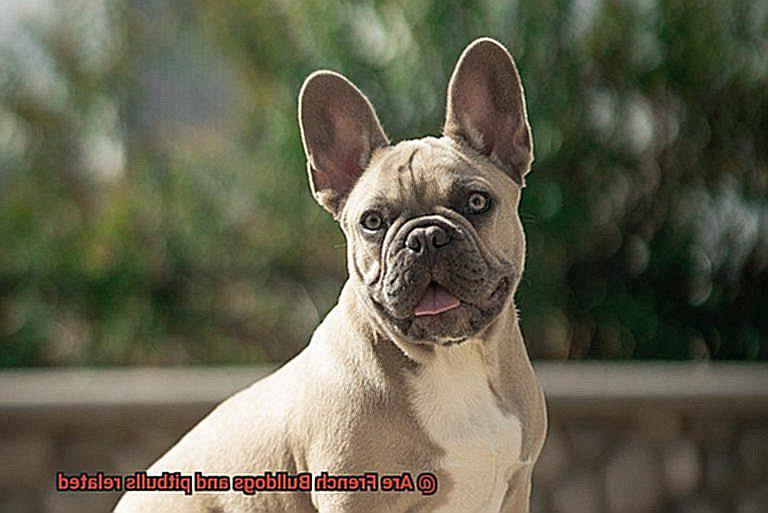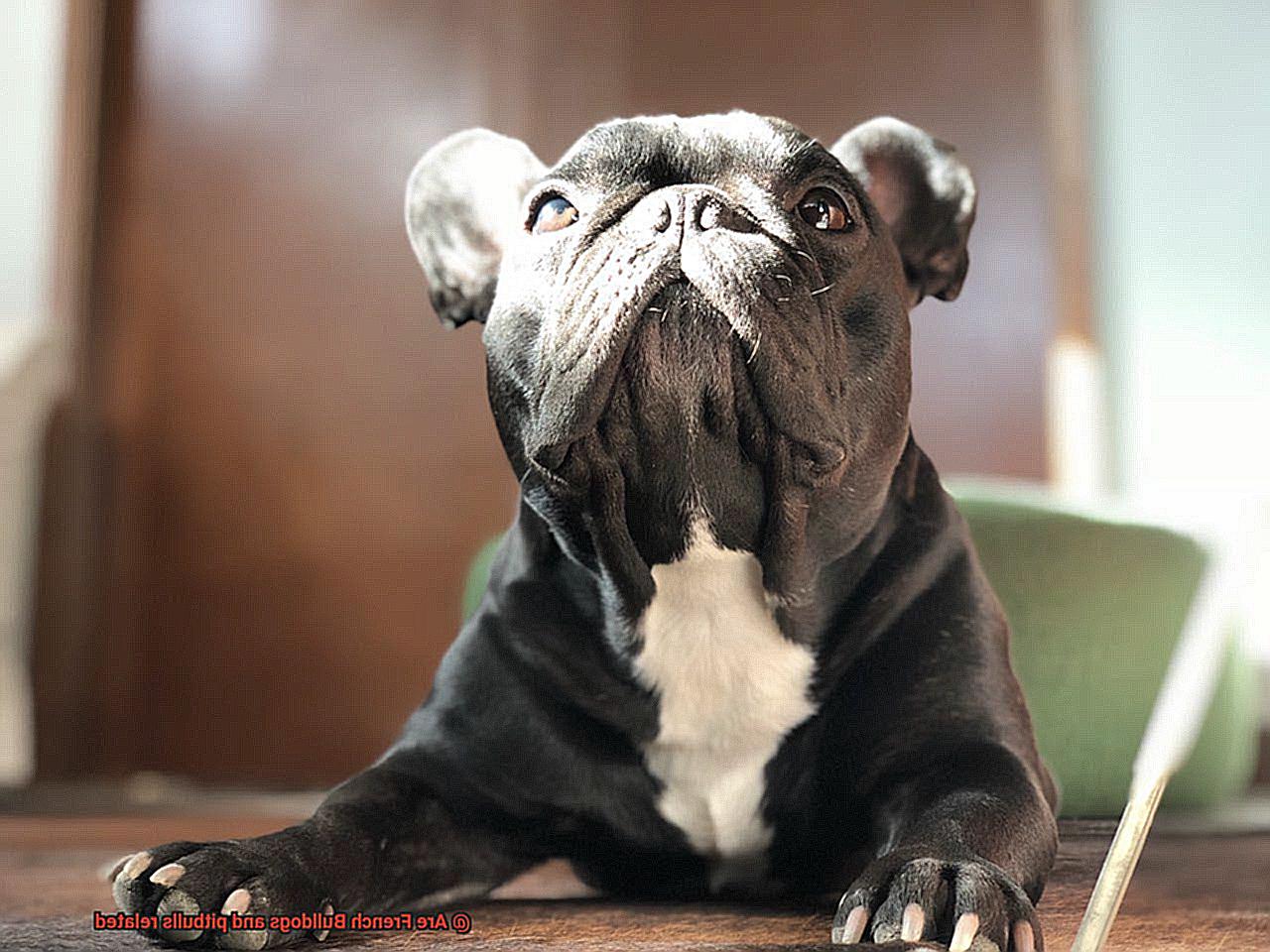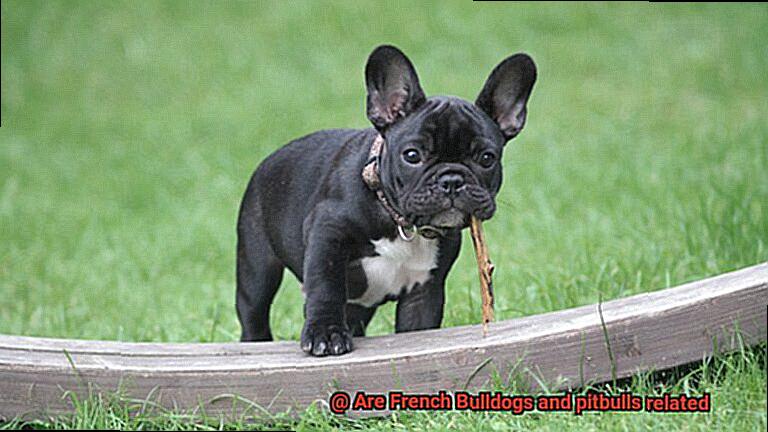Are French Bulldogs and pitbulls related?
This question has piqued the interest of dog lovers everywhere. French Bulldogs and Pitbulls are both captivating breeds, each with their own unique charm.
But do they share a close family tree? In this blog post, we’ll dive into the origins and history of these beloved dogs.
So get ready for an exciting journey through the world of French Bulldogs and Pitbulls as we unravel their relationship and discover what makes them stand out.
The Origin of French Bulldogs
Contents
- 1 The Origin of French Bulldogs
- 2 The Origin of Pitbulls
- 3 Common Ancestry of French Bulldogs and Pitbulls
- 4 Physical Characteristics of French Bulldogs
- 5 Physical Characteristics of Pitbulls
- 6 Temperament Differences between French Bulldogs and Pitbulls
- 7 Generalizations About These Breeds
- 8 Responsible Ownership and Proper Care for Both Breeds
- 8.1 Exercise: Keeping Them Fit and Fabulous
- 8.2 Nutrition: Fueling Their Mighty Appetites
- 8.3 Health Care: A Vital Aspect of Responsible Ownership
- 8.4 Grooming: Keeping Them Fresh and Fabulous
- 8.5 Training and Socialization: The Keys to a Well-Behaved Companion
- 8.6 Safety First: Creating a Secure Environment
- 9 Conclusion
These adorable and compact companions have an intriguing history that traces back to the 1800s. In this blog post, we will delve into the origin of French Bulldogs, explore their distinct differences from pitbulls, and shed light on the factors that make them a cherished breed.
The Journey from England to France:
During the Industrial Revolution, lace workers from Nottingham migrated to France in search of better opportunities. They brought along their small bulldogs, which soon became a sensation among the locals. These bulldogs, known as “Toy Bulldogs” or “Bouledogues Français,” quickly emerged as popular companions across various social classes in France.
A Symbol of Parisian Culture:
French Bulldogs’ popularity soared, and they soon became emblematic of Parisian culture. These charming canines were often seen lounging in cafes, keeping artists company in their studios, and even strutting down fashion runways. With their expressive eyes and unique physique, French Bulldogs became inseparable from the image of Parisian elegance.
Differentiating French Bulldogs from Pitbulls:
While both French Bulldogs and pitbulls fall under the umbrella term of “bulldogs,” it is important to understand that they have distinct origins and characteristics. French Bulldogs are descendants of English Bulldogs selectively bred for their small size and unique physical attributes. On the other hand, pitbulls encompass various breeds such as the American Pit Bull Terrier and Staffordshire Bull Terrier, each with its own lineage.
Characteristics and Traits:
French Bulldogs possess a compact body, large head, and distinctive bat-like ears. They are known for their friendly and affectionate nature, making them wonderful family pets. Pitbulls, on the other hand, boast a muscular build, strong jaws, and a powerful physique. They are often described as energetic and loyal when trained and socialized properly.
The Origin of Pitbulls
A breed that has captured the hearts of many with their undeniable strength, athleticism, and loyalty. But have you ever wondered where these incredible dogs come from? Sit back, relax, and let me take you on a journey through time as we unravel the captivating origin of Pitbulls.
The United Kingdom: Where It All Began
In the 19th century, the Pitbull breed emerged in the United Kingdom. Back then, bull-baiting was a popular sport, and these dogs were bred for one purpose: to bring down bulls. Can you imagine the strength and tenacity they possessed? It’s no wonder they became legendary.
From Bull-Baiting to Ratting
When bull-baiting was banned in the early 1800s (thank goodness for that.), Pitbulls found a new purpose. They became expert rat catchers and were also utilized as working dogs on farms. Talk about versatility.
The Fighting Pits and the Name “Pitbull”
You might be wondering how these dogs got their name. Well, it’s quite simple really. They were often pitted against each other or other animals in fighting pits. Hence, they became known as Pitbulls. But don’t let their name fool you – these dogs are so much more than fighters.
A Mix of Breeds
The original Pitbulls were a result of careful breeding, combining various breeds like Bulldogs and Terriers. Bulldogs brought their strength to the mix, while Terriers added agility and tenacity. It was truly a recipe for success.
Across the Atlantic: The American Journey
In the late 19th century, Pitbulls made their way to the United States, where they quickly gained popularity as versatile working dogs. American breeders took the breed to new heights, refining their traits to suit specific purposes like hunting, guarding, and even companionship.
Pitbull: An Umbrella Term
It’s essential to note that the term “Pitbull” is often used as an umbrella term that encompasses several breeds or mixed breeds with similar physical characteristics. Breeds like the American Pit Bull Terrier, Staffordshire Bull Terrier, and American Staffordshire Terrier all fall under this umbrella.
Common Ancestry of French Bulldogs and Pitbulls
When it comes to the world of canines, the French Bulldog and Pitbull stand out as two beloved breeds with a shared history. Both belonging to the Mastiff family, these breeds trace their roots back to ancient times, showcasing their muscular build, strong jaws, and protective nature. In this article, we will dive deeper into the captivating tale of their common ancestry and explore how they have evolved into the wonderful companions we know today.
The Bull and Terrier Breed:
In the early 19th century, breeders sought to create a new breed by crossing Bulldogs with Terriers. This resulted in the Bull and Terrier breed, which later underwent refinement to give rise to two distinct breeds: the English Bulldog and the Staffordshire Bull Terrier. It is important to note that the English Bulldog played a significant role in shaping both French Bulldogs and Pitbulls.
The Evolution of the French Bulldog:
Initially bred in England for bull-baiting, Bulldogs faced a change in fortunes due to evolving attitudes towards animal cruelty. Legislation was passed to ban blood sports like bull-baiting, leading breeders to shift their focus towards developing Bulldogs into companion dogs with milder temperaments. They crossed Bulldogs with smaller terrier breeds, resulting in a smaller version known as the Toy Bulldog or Miniature Bulldog.
During the Industrial Revolution, these Toy Bulldogs found their way to France through lace workers. In France, selective breeding further refined their characteristics, leading to the development of what we now know as the French Bulldog.
With their distinctive “bat-like” ears and snub nose, French Bulldogs became popular for their friendly and affectionate nature, making them exceptional companions for families and individuals alike.
The Rise of the Pitbull:
Across the Atlantic in America, Bulldogs were also undergoing a transformation. They were crossed with various terrier breeds, resulting in the creation of the American Pit Bull Terrier or simply Pitbull. Pitbulls were initially bred for dog fighting, but their loyal and affectionate nature soon gained recognition, leading to their popularity as family pets, working dogs, and therapy dogs.
Distinct Physical and Temperamental Differences:
While French Bulldogs and Pitbulls share a common ancestry, they have distinct physical and temperamental differences. French Bulldogs are small, compact dogs with a friendly and easygoing nature. Their sturdy build and strong jaws inherited from their Mastiff ancestry make them resilient companions. On the other hand, Pitbulls are medium to large-sized dogs with an athletic appearance. Their loyalty and protective instincts make them great working dogs and beloved family pets.
Physical Characteristics of French Bulldogs
In the vast world of dog breeds, French Bulldogs and pitbulls stand out for their unique physical characteristics. While they may share some similarities, it is essential to understand the distinctive features that differentiate these two breeds. In this blog post, we will delve into the physical traits that make French Bulldogs truly one-of-a-kind.
Size Matters:
French Bulldogs are compact and small-sized dogs, weighing between 16 to 28 pounds (7 to 13 kg) and standing around 11 to 12 inches (28 to 30 cm) tall at the shoulder. On the other hand, pitbulls have a medium to large-sized build, weighing between 30 to 85 pounds (14 to 39 kg) and measuring around 17 to 21 inches (43 to 53 cm) in height.
Build:
French Bulldogs boast a square-shaped body, with a broad chest, sturdy legs, and a thick neck. Their heads are large and square-shaped, featuring a short snout and a prominent forehead. Conversely, pitbulls exhibit a more athletic and leaner build, with well-defined muscular structures, deep chests, and powerful hindquarters. Their heads are broader, showcasing a strong jawline.
Coat Characteristics:
The short coat of French Bulldogs is smooth, fine in texture, and often soft to the touch. This sleek appearance adds to their charm. French Bulldogs come in various colors like brindle, fawn, white, cream, or a combination of these hues. Pitbulls, on the other hand, sport a denser coat than French Bulldogs. While their coat is also smooth and short, it provides them with more protection. Pitbulls come in an array of colors such as black, blue, brown, red, or brindle.
Distinctive Ears:
One of the most notable physical features of French Bulldogs is their bat-like ears. These medium-sized ears are rounded at the top and set high on the head. They can either stand erect or have a slight flop at the tip, giving them an endearing expression. Conversely, pitbulls typically possess short to medium-sized rose-shaped ears, which fold backward and partially expose the inner ear.
Tails Tell a Tale:
French Bulldogs have naturally short and straight tails, often referred to as “stumpy” tails. Positioned low, they are usually held straight or slightly curved upwards. In contrast, pitbulls have longer tails that taper towards the end. Set low and hanging down, their tails reach just above their hocks.
Physical Characteristics of Pitbulls
Today, we’re focusing on one of the most iconic and enigmatic breeds out there – Pitbulls. So, grab a cup of coffee, get comfortable, and let’s explore the physical characteristics that make these dogs so distinctive.
Broad and Strong Jawline:
When you think of a Pitbull, what’s the first thing that comes to mind? That’s right – their broad and strong jawline. These dogs possess a well-defined jaw structure that speaks volumes about their power and determination. With a wide mouth and strong teeth, Pitbulls have become renowned for their ability to deliver an impressive bite force.

Muscular Physique:
Prepare to be awed by the sheer strength and agility of Pitbulls. Their muscular physique is a testament to their athleticism and active nature. With well-developed muscles in their chest, shoulders, and hindquarters, these dogs are built for action. Whether it’s running, jumping, or playing fetch, they excel in physical activities like no other.
Short Coat:
Pitbulls sport a short coat that is not only practical but also adds to their charm. This smooth and shiny coat requires minimal grooming and comes in a variety of colors – from striking brindle patterns to solid hues like black, white, brown, or any combination thereof. Their low-maintenance coats make them ideal companions for those who prefer fuss-free grooming routines.

Size Doesn’t Define Them:
Despite their powerful appearance, Pitbulls fall under the medium-sized category when it comes to dog breeds. Adult males typically stand at around 18 to 20 inches tall at the shoulder and weigh between 35 to 60 pounds. Females tend to be slightly smaller, measuring about 17 to 19 inches in height and weighing between 30 to 50 pounds. Remember, though, that size alone doesn’t define the incredible spirit and personality of these dogs.
Striking Head Shape:
The heads of Pitbulls are a sight to behold. Their broad skulls and well-defined cheek muscles create a balanced and proportionate look. Their eyes, which can be round or almond-shaped, exude intelligence and loyalty. And let’s not forget their ears – whether cropped or left natural, they add an extra touch of uniqueness to these magnificent creatures.
Tails: Docked or Natural:
Pitbulls traditionally had their tails docked in some countries, while others prefer leaving them natural. The natural tail is thick at the base and tapers towards the tip, adding to their overall aesthetic appeal. Regardless of tail style, it’s important to remember that their wagging enthusiasm and joyful demeanor remain constant.
Temperament Differences between French Bulldogs and Pitbulls
French Bulldogs vs. Pitbulls: Temperament Showdown.
When it comes to choosing a furry friend, temperament is a crucial factor to consider. French Bulldogs and Pitbulls are two popular breeds with distinct personalities. Let’s dive into their temperaments to help you decide which breed is the right fit for your lifestyle.
Affectionate French Bulldogs:
French Bulldogs are known for their friendly and affectionate nature. They love being around people and thrive on human companionship. If you’re looking for a dog that will shower you with love and cuddles, the French Bulldog is your go-to breed. They make excellent family dogs and are usually good with children and other pets.
Protective Pitbulls:
Contrary to popular belief, Pitbulls can be gentle and loving companions when properly trained and socialized. However, their protective instincts are stronger compared to French Bulldogs. Pitbulls have a natural inclination towards protecting their loved ones, making them excellent guard dogs. They may be more wary of strangers but can be trained to behave politely around unfamiliar people.
Relaxed Frenchies vs. Energetic Pits:
French Bulldogs have a laid-back and relaxed demeanor, making them perfect for those who prefer a more low-key companion. These little couch potatoes enjoy lounging around the house and being close to their owners. On the other hand, Pitbulls have a higher energy level and require more physical exercise and mental stimulation. Regular playtime and exercise are essential for keeping them happy and well-behaved.
Easygoing French Bulldogs vs. Determined Pitbulls:
French Bulldogs are known for their eagerness to please their owners, making training relatively easy. They are cooperative and respond well to positive reinforcement methods. On the other hand, Pitbulls can be more stubborn at times and may require consistent and firm training techniques. Early socialization and obedience training are vital for raising a well-behaved Pitbull.
Watchdogs with a Difference:
French Bulldogs make excellent watchdogs, alerting their owners to any potential threats or strangers approaching their territory. However, they are not typically aggressive towards strangers. Pitbulls, on the other hand, have a stronger protective instinct and may be more wary of unfamiliar people. Proper training and socialization can help ensure they are well-behaved around strangers.
Remember, individual temperament can vary within each breed, so it’s important to spend time with a dog before making your decision. Both French Bulldogs and Pitbulls can make wonderful companions, but their temperaments differ in significant ways. Consider your lifestyle, preferences, and the amount of time and effort you can dedicate to training and exercise when choosing between these two breeds.
Generalizations About These Breeds
When it comes to choosing the perfect furry companion, French Bulldogs and Pitbulls are two breeds that often come to mind. But what sets them apart? In this blog post, we will delve into the generalizations about these breeds, exploring their appearance, temperament, exercise needs, trainability, and health concerns. So grab a cup of coffee and let’s dive in.
Appearance:
- French Bulldogs: These adorable little charmers are known for their compact size, muscular build, wrinkled face, bat-like ears, and smooth coat. They come in various colors like fawn, brindle, and pied.
- Pitbulls: With a medium to large-sized frame and an athletic build, Pitbulls exude strength and power. Their short coat comes in an array of colors and patterns, making them truly eye-catching.
Temperament:
- French Bulldogs: Frenchies are playful, adaptable, and possess a heart of gold. They make excellent companions for families with children and get along well with other pets.
- Pitbulls: Loyal, protective, and full of energy – that’s what defines Pitbulls. With proper training and socialization, these dogs can be gentle and loving towards their family members.
Exercise Needs:
- French Bulldogs: If you’re looking for a low-energy breed that enjoys short walks and indoor playtime, French Bulldogs fit the bill perfectly. They appreciate a cozy spot on the couch just as much as a leisurely stroll around the block.
- Pitbulls: On the other hand, Pitbulls thrive on physical activities that keep them mentally stimulated. Long walks, jogging sessions, playing fetch – you name it. These energetic pooches need regular exercise to keep them happy and healthy.
Trainability:
- French Bulldogs: Frenchies are intelligent, but they can be a bit stubborn at times. Consistent training methods that focus on positive reinforcement work best for these independent-minded dogs.
- Pitbulls: With their eagerness to please, Pitbulls are highly trainable. They excel in obedience training and are quick to learn new commands. Positive reinforcement and a loving approach go a long way with these smart canines.
Health Concerns:
- French Bulldogs: Due to their brachycephalic nature (short skull shape), French Bulldogs may experience breathing difficulties and heat intolerance. They are also prone to joint problems, skin allergies, and eye conditions.
- Pitbulls: Hip dysplasia, allergies, and certain genetic conditions are some health concerns that Pitbulls may be susceptible to. Regular veterinary check-ups and a well-balanced diet are essential for their overall well-being.
Responsible Ownership and Proper Care for Both Breeds
As a proud French Bulldog owner, you know that owning a dog is more than just providing food and shelter. It’s about giving them the love, attention, and care they deserve. The same applies to Pitbulls, another incredible breed that deserves responsible ownership and proper care. So, whether you’re a French Bulldog lover or considering adding a Pitbull to your family, let’s dive into the importance of responsible ownership and proper care for both breeds.

Exercise: Keeping Them Fit and Fabulous

French Bulldogs may not be the most energetic breed, but they still need regular exercise to maintain a healthy weight and prevent obesity-related health issues. However, due to their brachycephalic nature (short snouts), intense physical activities can strain their respiratory system. So, opt for leisurely walks or gentle play sessions to keep them active without overexerting them.
On the other hand, Pitbulls are energetic bundles of joy who thrive on physical activity. They need ample exercise to prevent boredom and destructive behaviors. Engage them in activities like fetch, agility training, or long walks to keep their minds and bodies stimulated.
Nutrition: Fueling Their Mighty Appetites
To keep both breeds healthy and happy, it’s crucial to provide a balanced diet that meets their nutritional needs. Consult with your veterinarian to determine the appropriate diet for your French Bulldog or Pitbull based on their age, weight, and specific dietary requirements.
Health Care: A Vital Aspect of Responsible Ownership
Regular veterinary check-ups and vaccinations are essential for maintaining the health and well-being of both French Bulldogs and Pitbulls. These visits help detect any underlying health issues early on and ensure that your furry friend is up-to-date on all necessary vaccinations.
Grooming: Keeping Them Fresh and Fabulous
French Bulldogs have short coats that require minimal grooming. A quick brush to remove loose hair and regular cleaning of their facial folds should suffice. Pitbulls, on the other hand, have short coats that shed moderately. Regular brushing will help keep their coats healthy and reduce shedding.
Training and Socialization: The Keys to a Well-Behaved Companion
Both French Bulldogs and Pitbulls benefit greatly from early socialization and training. It helps them become well-behaved members of society and prevents aggression or fear-based behavior. Enroll your pup in obedience classes or hire a professional trainer to provide them with the guidance they need to thrive.
Safety First: Creating a Secure Environment
Responsible ownership also includes providing a safe environment for both breeds. Ensure that your fences are secure, keeping harmful substances out of reach, and providing proper shelter and bedding for your furry friend to relax in comfort.
Conclusion
In conclusion, French Bulldogs and pitbulls are not closely related.
While they may share some physical similarities, such as a muscular build and short coat, their origins and breed histories are distinct. French Bulldogs originated in France as a companion breed, while pitbulls have a more complex background as working dogs.
Despite any superficial resemblances, these two breeds have different temperaments, health concerns, and care requirements.




